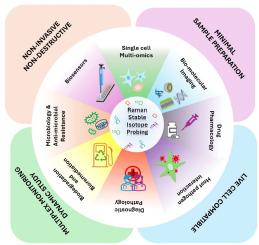Raman stable isotope probing (SIP): A novel bio-analytical tool
IF 12
1区 化学
Q1 CHEMISTRY, ANALYTICAL
引用次数: 0
Abstract
Raman spectroscopy is a versatile non-destructive analytical technique that involves minimal sample preparation to assess the biomolecular compositions from a wide range of biological samples, making it a powerful adjunct tool in multiomics. However, getting the precise quantitative information about these biomolecules is still challenging. In this review, we discuss the theoretical aspects, experimentation strategy, and applications of Raman spectroscopy combined with stable isotopes of bioessential elements such as carbon-13, hydrogen-2 (deuterium), nitrogen-15, and oxygen-18 for multiomics. This technology has been termed as Raman stable isotope probing (Raman SIP) and can be used for the detection and mapping of biomolecules, distribution of biomolecules, and tracking biological pathways in action. This review covers a wide variety of applications of the Raman SIP method highlighting Raman peaks specific to biomolecules probed with different isotopes. We have also covered the current technical limitations and future perspectives of this approach in biomolecule detection and monitoring, and the possibility of addressing it in the future. This review will also take readers' interests to the possible unexplored domains of Raman SIP for broader adoptions in the chemical biology, and analytical biochemistry fields.

拉曼稳定同位素探测(SIP):一种新的生物分析工具
拉曼光谱是一种通用的非破坏性分析技术,只需要最少的样品制备,就可以从广泛的生物样品中评估生物分子组成,使其成为多组学中强大的辅助工具。然而,获得这些生物分子的精确定量信息仍然具有挑战性。本文综述了拉曼光谱与碳-13、氢-2(氘)、氮-15和氧-18等生物必需元素稳定同位素结合在多组学中的理论、实验策略和应用。这项技术被称为拉曼稳定同位素探测(Raman SIP),可用于检测和绘制生物分子,生物分子的分布以及跟踪生物活动途径。本文综述了拉曼SIP方法的各种应用,重点介绍了用不同同位素探测生物分子特有的拉曼峰。我们还介绍了这种方法在生物分子检测和监测方面的当前技术限制和未来前景,以及未来解决它的可能性。这篇综述也将把读者的兴趣带到拉曼SIP可能未被探索的领域,以便在化学生物学和分析生物化学领域得到更广泛的应用。
本文章由计算机程序翻译,如有差异,请以英文原文为准。
求助全文
约1分钟内获得全文
求助全文
来源期刊

Trends in Analytical Chemistry
化学-分析化学
CiteScore
20.00
自引率
4.60%
发文量
257
审稿时长
3.4 months
期刊介绍:
TrAC publishes succinct and critical overviews of recent advancements in analytical chemistry, designed to assist analytical chemists and other users of analytical techniques. These reviews offer excellent, up-to-date, and timely coverage of various topics within analytical chemistry. Encompassing areas such as analytical instrumentation, biomedical analysis, biomolecular analysis, biosensors, chemical analysis, chemometrics, clinical chemistry, drug discovery, environmental analysis and monitoring, food analysis, forensic science, laboratory automation, materials science, metabolomics, pesticide-residue analysis, pharmaceutical analysis, proteomics, surface science, and water analysis and monitoring, these critical reviews provide comprehensive insights for practitioners in the field.
 求助内容:
求助内容: 应助结果提醒方式:
应助结果提醒方式:


